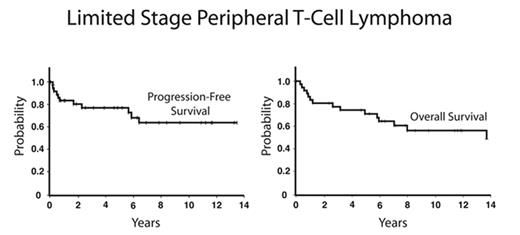Abstract
The outcome of treatment for the majority of patients with peripheral T-cell lymphoma who have advanced-stage disease is worse than similar patients with diffuse large B-cell lymphoma. Patients with limited-stage diffuse large B-cell lymphoma have a good prognosis and are often treated differently than patients with advanced-stage disease. There is little information on results of treatment for patients with limited-stage peripheral T-cell lymphoma. We have performed a retrospective review of patients with limited-stage peripheral T-cell lymphoma who were identified in the database of the Nebraska Lymphoma Study Group. Patients with masses ≥10 cm. and those with B symptoms were excluded. We identified 36 patients with non bulky stage I-A (n=21, 58%) or II-A (n=15, 42%) disease who were diagnosed between and April, 1984 and February, 2006. The median age was 59 (range 18–87) years. There were 20 (56%) males. Histology was classified according to the World Health Organization (WHO) classification. Three patients (8%) had angioimmunoblastic T-cell lymphoma, 25 (69%) had peripheral T-cell lymphoma, unspecified, and 8 (22%) had anaplastic large cell lymphoma. Thirty patients (83%) were treated with anthracycline- or mitoxantrone-based therapy, 5 (14%) were treated with radiation, alone, and 1 (3%) received other chemotherapy. Seventeen patients (47%) were treated with combined chemotherapy and radiation. The median follow-up of surviving patients is 108 (range 12–235) months. The progression-free survival and overall survival are displayed in the figure, below. The actuarial 5-year and 10-year progression-free survival rates are 77% and 63%, respectively. The corresponding values for overall survival are 71% and 56%, respectively. Univariate analysis did not demonstrate significant differences in the risk of treatment failure or death when the influence of histology, stage (I vs. II), and type of treatment (chemotherapy vs. chemotherapy + radiation; <3 cycles of chemotherapy vs. ≥3 cycles) were analyzed, although the numbers in each group were relatively small. Similarly, the outcome was not influenced by age, gender, performance status, LDH level, bulk, or the presence of extranodal disease. These results demonstrate that long-term progression-free survival can be observed for patients with limited-stage peripheral T-cell lymphoma. These results are better than the results of treatment for higher stages of peripheral T-cell lymphoma. Currently available therapy for limited-stage peripheral T-cell lymphoma can achieve results that are close to the results of treatment for limited-stage diffuse large B-cell lymphoma.
Author notes
Disclosure: No relevant conflicts of interest to declare.


